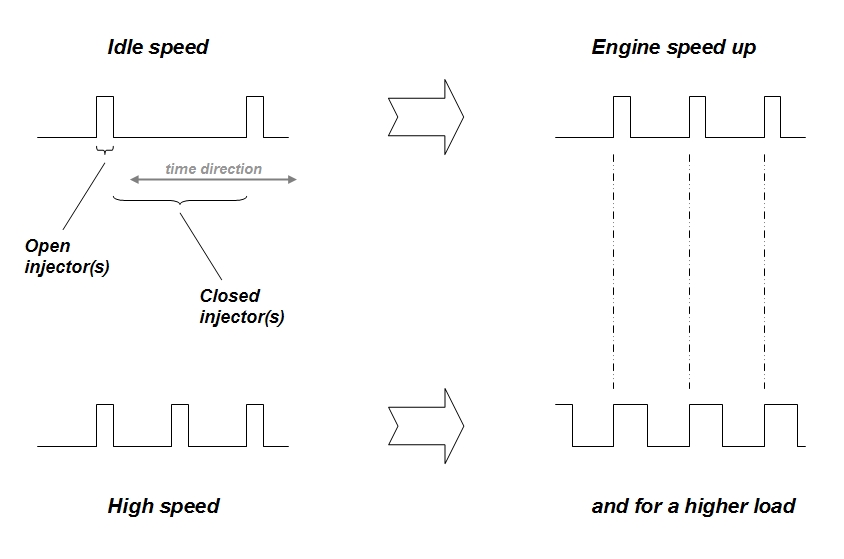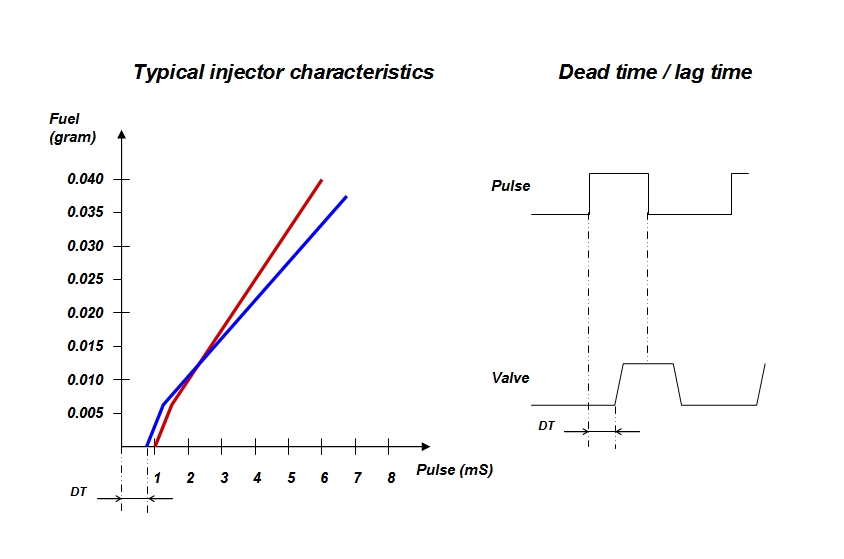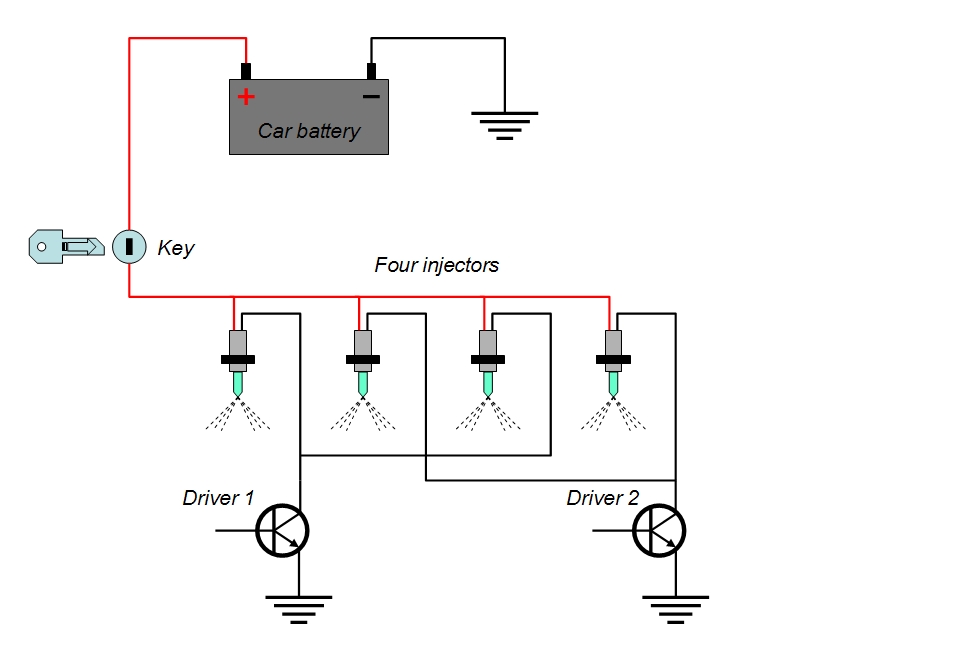The principle, most cars use to regulate the fuel injectors, is:
One Channel Multipoint System or ”simultaneous injection”
The purpose to this is:
Only one driver/transistor fire all injectors at the same time.
That also means: All injectors are parallel electronically connected to each other.
A injector inject a relative large amount of fuel. Therefore is the opening time short but the frequency for the - on and off - sequences is high. A frequent on and off sequence of the injector/injectors cause turbulence. Turbulence together with a high disintegrate/atomize factor of the fuel, will improve the action of the gas/fluid mixture step. We now talking about a multi-point system! Then all injectors are open and close at the same time. One can not synchronize each cylinder so that every injector sprays the inlet port just when it is open - this requires a sequential system.

Every injector is pressurized by fuel and the opening time is very short. The opening time is something between 1 mS to 10 mS depending on the manufacture of your system and the engine load. The time the injector is closed is between 50 mS and 100 mS (on idle).
The terms ”opening time” and ”closing time” is here (and in related documents from this website) equivalent to the electrical signal characteristics - not the time as a fuel injector's valve is open or closed. Actually, one can consider both the pulse width and the actual opening time in the same way, but let me explain the problem in more detail: A fuel injector effective opening time or interval at which the injector inject fuel, takes place a little time after the electrical pulse. The reason to this behavior depends on electrical induction in the injector coil and mechanical inertia. The delay is approximately 1 mS and the time it takes to start to move the valve is called dead time or lag time. When the electrical pulse ends so will the valve start to close, but again, it takes time before the valve closes. Although this time has basically the same duration as the dead time interval but tends to be shorter. Manufacturers of fuel injector's ensure however that these delays not affect the linearity. The delays (or the lag time) vary depending on the manufacturer, but the fuel mass per unit always follow the electrical signal variations by a linear function. It is only at very short opening times as an injector may be nonlinear. More info about injector's linearity further down the page.
The frequencies of the injectors opening sequence depend of the engine speed. So if the speed/RPM increases, the frequency do the same. The opening times also depend of the engine load, as I said. It isn't any connection between the frequency and the opening time. Instead they work completely independently to each other.

When the fuel is ethanol every injector need to be open longer than normal. That issue would be an easy problem for the engine fuel-computer, but the extra amount of fuel is too far away from the normal variations of different petrol qualities, so the computer soon reaches the limit and that limit is also differing dependent on the manufacture of the fuel-computer.
This is simply a limitation of the electronics, nothing more, but there is an explanation in this way to arrange such a system here and it spells actually for safety. When the computer reaches the limit of what it believes is far too much fuel, interprets the computer that this probably is a fuel leak. This is not normal and therefore illuminates the engine faults LED also.
The idea is that such an indication may prevent an accident - a fire.
There have been rumors on the Internet that you can not extend the opening time of an injector because the pulses get inside of each other when the engine reaches a certain speed. Interpret the figure below; you can easily get this idea. In fact, the distances between each gap / interval are greater. If we start with the engine idling and see how long an intake valve can be open, then the idle speed is for about 800 rpm - that will be about 13 rev/sec. The intake port is open a half-crankshaft turns every two laps, 1/(13x2) seconds - it is 38 mS. The closing-time or the interval to the next pulse will be 38x3 = 114 mS. Would we have a sequential system should every injector have 38 mS to inject the right amount of fuel. Compare then with a multi-point system in which the opening time at idle is about 2 mS! For a sequential system is all injectors timed and the opening time is a little longer, let say 3 mS. Together with the closing-time, we have 3 mS plus 114 mS closing-time. So one injector is open 2.5% of the maximum time it can be open.
If we choose a speed of 10000 rpm so it will be 167 rev/sec. The time the inlet valve is open becomes then 3 mS and the interval is 9 mS. The injector can then be kept open 25% of the maximum time only during the intake stroke. Would an engine manufacturer not count on certain over dimension when the engine load and speed is a maximum? Let assume that the injector is open 50% at maximum load. Then there is still room to double the fuel in the event you would like to tune up the engine! Instead to tune up we increases the pulse duration by 40% for an injector which is open 50% of the maximum time, so will the total time be 70% and then there are still 30% of time to squeeze out of a trim (at max load). I think there is room, what do you think?

The point is that there are not good enough with a linear change.
With the use of low energy fuels arises a little problem.
The curve that is applicable to petrol does not apply to all low energy fuels. If your computer opens the throttle for the new fuel as it did for petrol, will the engine either go rich or lean, At least for a short time before the computer has regulate the dosage. The lambda sensor knows that the engine has received wrong amount of fuel and the system will resets itself.
When using ethanol or E85 can one however count with a linear change. The computer can open for the fuel as it did for petrol - then it works properly, thus follow the same graph (mapping) as petrol. Some problems remain - and that applies the settings when the lambda control is disconnected.
The mapping is usually good enough as long as one are dealing with ordinary commercial vehicles, but how large the pulse extension shall be is much more difficult to predict - it depends on the fuel injector's linearity or more correctly; the slope of the linearity graph. If one increasing the pulse length by 30%, so it does not mean that the fuel will increase by 30%. Maybe the quantity only increase by 25% or maybe the increase goes towards 40%...

It is important to understand that a fuel injector have a lag time, a dead time before it opens. The blue injector has a dead time of 0.8 mS but once it opens it acts linear almost immediately. The nonlinear part is usually attended behind the opening time the engine has at idle and can therefore be ignored. Pulse widths below 0.8 mS will not affect the injectors in the example above. The linearity is changed if the supply voltage is changed but the fuel computer can compensate that pretty easily. With my IPE circuits can one decide which pulse extension that matching the injector linearity best through one or two potentiometers. Although, the pulse-linearity can be changed too but should usually be kept as high as possible.
This image shows a cross between the usual multi-point system and a sequential system. One channel is then two channels - two channels multi-point... or you can also see it as a division into groups. A V8 engine can have this configuration, in which two drivers share one half of the injectors.
However, this picture does not show the principle for a V8.

DIFFERENT FUEL INJECTIONS SYSTEMS
Single-point or throttle body injections (TBI)The earliest and simplest type of fuel injection, single-point simply replaces the carburetor with one or two fuel injector nozzles
in the throttle body, which is the throat of the engine's air intake manifold. For some automakers, single-point injection was a stepping stone to the more
complex multi-point system. Though not as precise as the systems that have followed, TBI meters fuel better than a carburetor and are less expensive and easier
to service.
Port or multi-point fuel injection (MPFI)
Multi-point fuel injection devotes a separate injector nozzle to each cylinder, right outside its intake port, which is why the
system is sometimes called port injection. Shooting the fuel vapor this close to the intake port almost ensures that it will be drawn completely into the
cylinder. The main advantage is that MPFI meters fuel more precisely than do TBI designs, better achieving the desired air/fuel ratio and improving all related
aspects. Also, it virtually eliminates the possibility that fuel will condense or collect in the intake manifold. With TBI and carburetors, the intake manifold
must be designed to conduct the engine's heat, a measure to vaporize liquid fuel. This is unnecessary on engines equipped with MPFI, so the intake manifold can
be formed from lighter-weight material, even plastic. Incremental fuel economy improvements result. Also, where conventional metal intake manifolds must be
located atop the engine to conduct heat, those used in MPFI can be placed more creatively, granting engineers design flexibility.
Sequential fuel injection (SFI)
Sequential fuel injection, also called sequential port fuel injection (SPFI) or timed injection, is a type of multi port injection.
Though basic MPFI employs multiple injectors, they all spray their fuel at the same time or in groups. As a result, the fuel may ”hang around” a port for as
long as 150 milliseconds when the engine is idling. This may not seem like much, but it's enough of a shortcoming that engineers addressed it: Sequential fuel
injection triggers each injector nozzle independently. Timed like spark plugs, they spray the fuel immediately before or as their intake valve opens. It seems a
minor step, but efficiency and emissions improvements come in very small doses.
Direct injection
Direct injection takes the fuel injection concept about as far as it can go, injecting fuel directly into the combustion chambers,
past the valves. More common in diesel engines, direct injection is starting to pop up in gasoline engine designs and are common these days, sometimes called
DIG for direct injection gasoline. Again, fuel metering is even more precise than in the other injection schemes, and the direct injection gives engineers yet
another variable to influence precisely how combustion occurs in the cylinders. The science of engine design scrutinizes how the fuel/air mixture swirls around
in the cylinders and how the explosion travels from the ignition point. Things such as the shape of cylinders and pistons; port and spark plug locations;
timing, duration and intensity of the spark; and number of spark plugs per cylinder (more than one is possible) all affect how evenly and completely fuel
combusts in a gasoline engine. Direct injection is another tool in that discipline, one that can be used in low-emissions lean-burn engines.
Source: Cars.com

